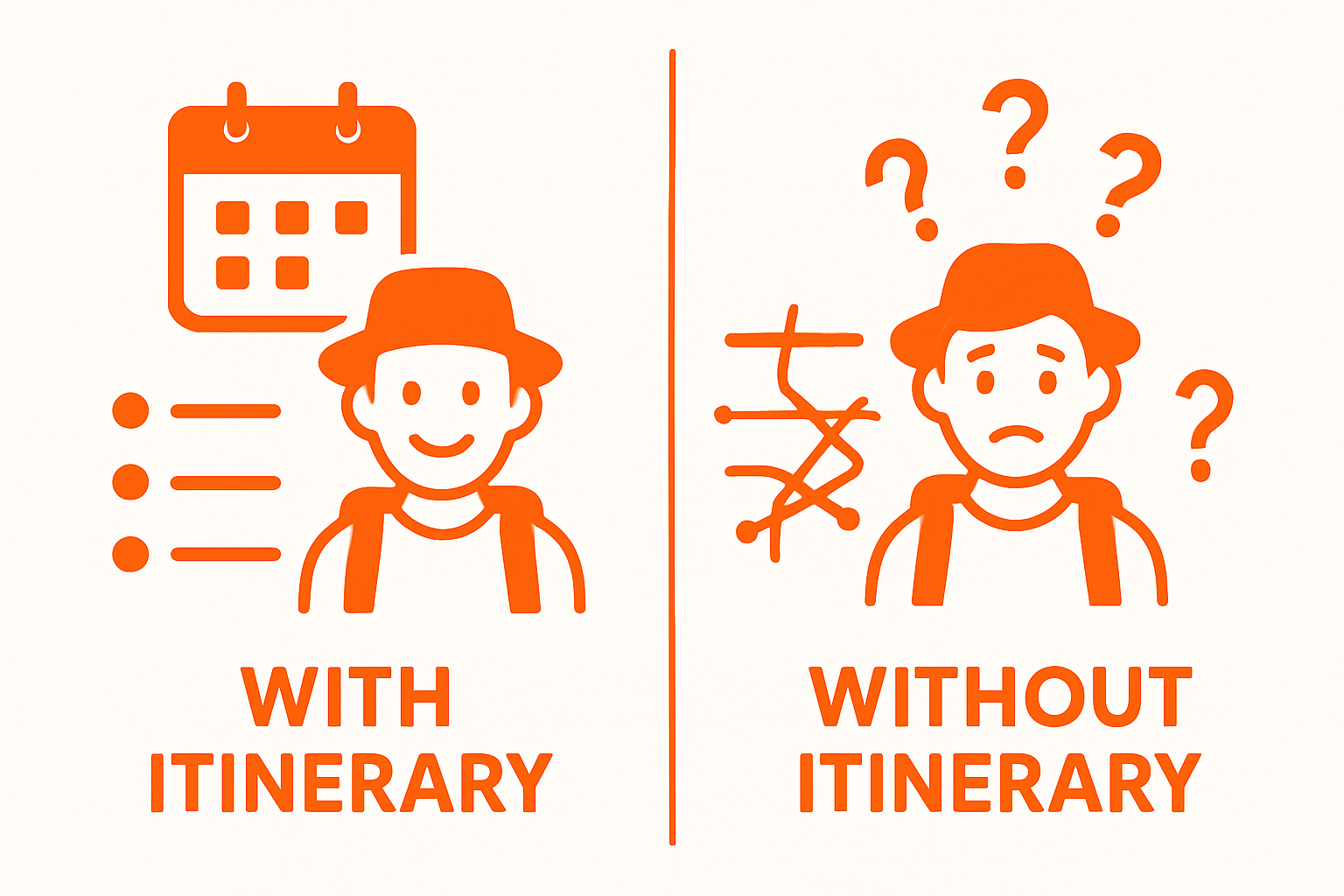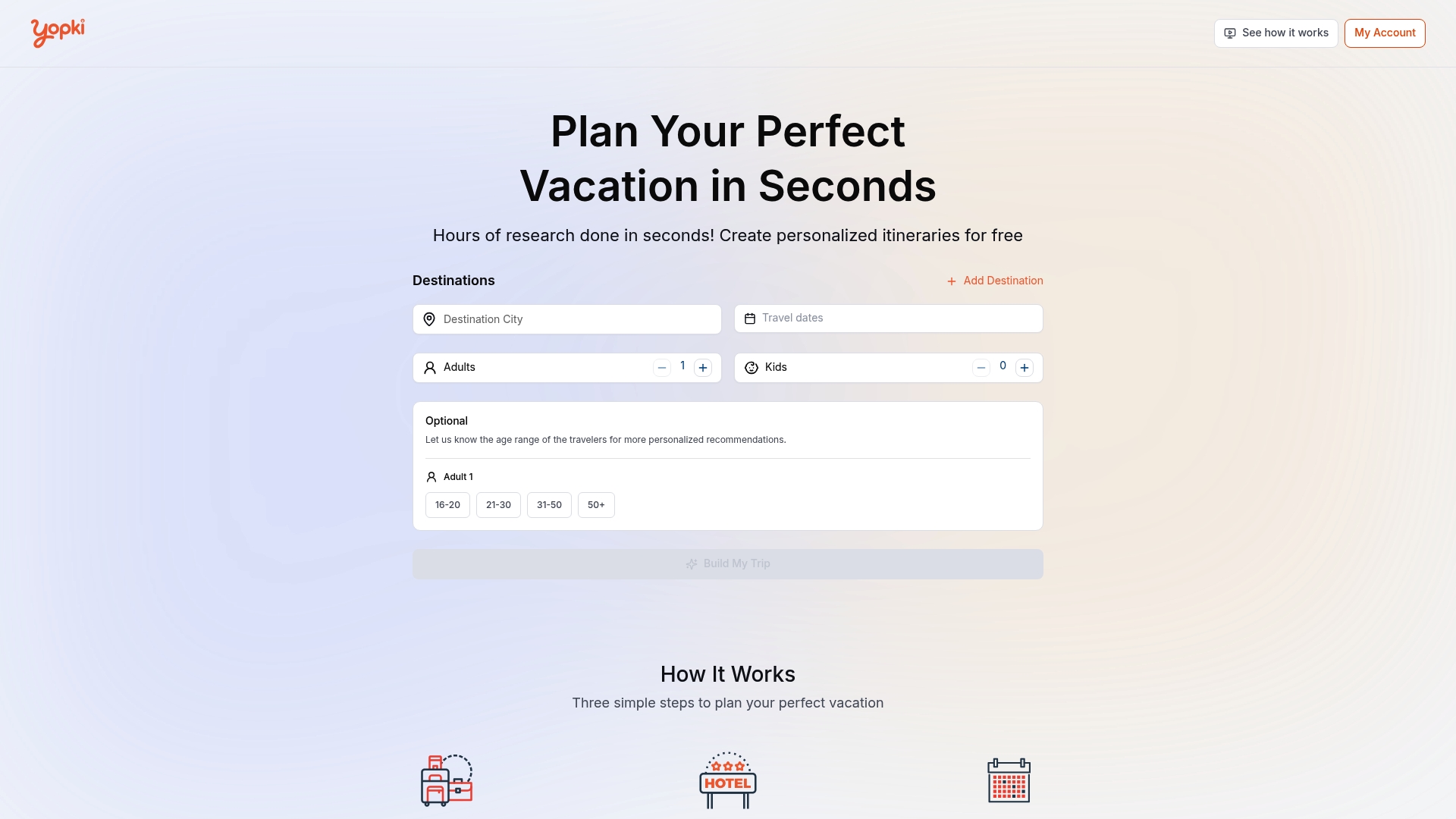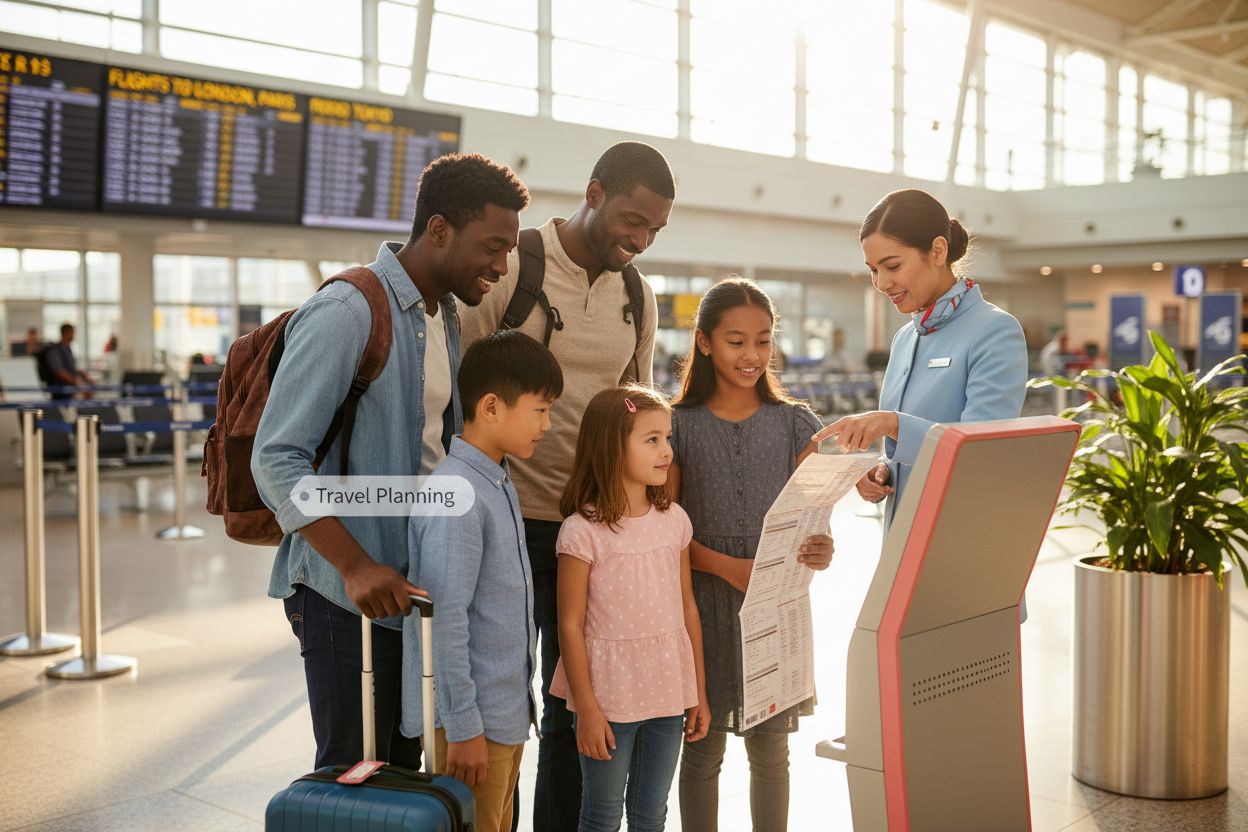Planning a trip can feel overwhelming with so many details to juggle. Get this. Travelers who use structured itineraries report significantly higher satisfaction and less stress during their adventures. Most people think improvising on vacation adds excitement, yet research shows that a solid itinerary actually leads to more memorable experiences without the chaos.
Table of Contents
- What An Itinerary Is And Its Role In Travel
- The Benefits Of Creating An Itinerary For Travelers
- How An Itinerary Enhances Trip Efficiency And Enjoyment
- Key Elements To Include In Your Itinerary Planning
- Real-World Examples Of Effective Itinerary Use
Quick Summary
| Takeaway | Explanation |
|---|---|
| Create a detailed travel itinerary. | An effective itinerary outlines transportation, accommodations, activities, and timelines for a well-organized trip. |
| Use itineraries to reduce travel stress. | A comprehensive itinerary provides a clear roadmap, eliminating last-minute decisions and enhancing emotional security. |
| Incorporate flexibility in scheduling. | Successful itineraries balance planned activities with open time to adapt to unexpected circumstances and preferences. |
| Prioritize essential documentation. | Key documents like passports, tickets, and emergency contacts ensure a smooth travel experience and mitigate logistical issues. |
| Plan for financial efficiency. | By pre-planning expenses, travelers can better manage budgets and identify cost-saving opportunities throughout their trip. |
What an Itinerary Is and Its Role in Travel
A travel itinerary is a comprehensive planning document that outlines the detailed schedule and sequence of events for your entire trip. Learn more about travel planning strategies to transform how you approach your journeys.
Understanding the Core Components
At its essence, an itinerary serves as a strategic roadmap for travelers, encompassing critical information about transportation, accommodations, activities, and timelines. Think of it as a personalized travel blueprint that transforms abstract destination dreams into a structured, actionable plan. According to TripAdvisor’s Travel Research, well-constructed itineraries can significantly enhance travel experiences by reducing uncertainty and maximizing enjoyment.
An effective itinerary typically includes several key elements:
- Precise travel dates and duration
- Detailed transportation arrangements (flights, trains, car rentals)
- Accommodation specifics with addresses and contact information
- Scheduled activities and planned experiences
- Estimated time allocations for each activity
- Potential backup plans or alternative options
The Strategic Importance of Travel Itineraries
Beyond mere scheduling, itineraries play a crucial psychological role in travel preparation. They provide travelers with a sense of control and confidence, mitigating anxiety about unknown destinations and potential logistical challenges. Comprehensive planning allows travelers to anticipate potential obstacles and develop contingency strategies, ensuring smoother, more enjoyable journeys.
Moreover, a well-crafted itinerary enables more efficient use of time and resources. By mapping out activities, transportation routes, and potential time investments, travelers can optimize their experiences, reducing unnecessary wandering and maximizing destination exploration. This strategic approach not only enhances travel satisfaction but also helps manage travel budgets more effectively.
The Benefits of Creating an Itinerary for Travelers
Creating a comprehensive travel itinerary transforms potential travel chaos into a structured and enjoyable experience. Learn how to simplify your travel planning with strategic preparation and smart organizational techniques.
Reducing Travel Stress and Uncertainty
Travel inherently involves numerous variables that can cause anxiety and unpredictability. A well-crafted itinerary acts as a protective shield against these uncertainties, providing travelers with a sense of control and preparedness. According to CDC Travel Guidelines, strategic travel planning can significantly mitigate potential health, safety, and logistical challenges before they become problematic.
Key stress reduction benefits include:
- Eliminating last minute decision making
- Providing a clear roadmap for daily activities
- Helping manage unexpected complications
- Creating a sense of emotional security
- Allowing flexible contingency planning
Maximizing Travel Efficiency and Experience
Beyond stress management, itineraries serve as powerful tools for optimizing travel experiences. Detailed planning enables travelers to maximize limited time and resources, ensuring each moment of the journey is purposeful and meaningful. By preemptively mapping transportation routes, activity sequences, and potential time investments, travelers can reduce unnecessary wandering and create more immersive destination experiences.
Moreover, advance planning allows for better financial management. Travelers who develop comprehensive itineraries can more accurately budget for expenses, identify potential cost saving opportunities, and avoid unexpected financial surprises. This strategic approach transforms travel from a potentially stressful endeavor into an exciting, well-orchestrated adventure that balances spontaneity with thoughtful preparation.

How an Itinerary Enhances Trip Efficiency and Enjoyment
Travel is an art form that requires strategic planning and thoughtful organization. Discover personalized travel strategies to elevate your journey from ordinary to extraordinary.
Time Management and Strategic Exploration
An expertly designed itinerary serves as a powerful tool for maximizing travel experiences by transforming limited time into meaningful moments. According to research from the University of Montana, travelers with structured plans experience significantly higher satisfaction levels and create more lasting memories.
Effective time management through itineraries enables travelers to:
- Prioritize must see destinations
- Balance exploration with relaxation
- Minimize unnecessary transit time
- Reduce decision fatigue during trips
- Optimize routing and transportation
Financial and Logistical Optimization
Strategic travel planning directly impacts financial efficiency, allowing travelers to allocate resources more intelligently. By pre planning activities, transportation, and accommodations, travelers can identify cost saving opportunities, avoid unexpected expenses, and create more predictable budgeting scenarios.
Moreover, comprehensive itineraries provide a psychological safety net. They transform potential travel anxiety into confident exploration, allowing travelers to immerse themselves fully in new experiences without constant logistical concerns. The mental bandwidth freed by thorough preparation enables more genuine connections with destinations, cultures, and personal travel experiences.
Key Elements to Include in Your Itinerary Planning
Comprehensive travel planning requires strategic attention to detail and anticipation of potential scenarios. Explore effective trip organization techniques to create a robust and adaptable travel blueprint.
Essential Documentation and Logistical Details
According to AAA Travel Guidelines, crafting a thorough itinerary demands meticulous inclusion of critical information that ensures smooth travel experiences. Proper documentation serves as the foundation of successful trip planning, providing travelers with a comprehensive reference point for their entire journey.
Key documentation elements to incorporate include:
- Passport and visa details with expiration dates
- Transportation tickets and reservation confirmations
- Accommodation booking information
- Emergency contact numbers
- Travel insurance policy details
- Health insurance documentation
- Digital and physical copies of important documents
Strategic Activity and Contingency Planning
Beyond basic documentation, a well structured itinerary must balance structured planning with flexibility. Successful travel preparation involves creating a framework that allows spontaneity while maintaining overall trip objectives. This approach enables travelers to adapt to unexpected circumstances without compromising the core travel experience.
Effective itineraries should include flexible scheduling that accounts for potential changes, unexpected delays, and personal energy levels. By building buffer time between activities and maintaining a balanced mix of planned experiences and open exploration windows, travelers can create a more enjoyable and less stressful travel experience that accommodates both structured goals and serendipitous discoveries.
Real-World Examples of Effective Itinerary Use
Travel experiences transform from ordinary to extraordinary through strategic planning and thoughtful preparation. Learn how to maximize your travel potential by understanding practical applications of comprehensive itinerary design.
Business and Conference Travel Scenarios
Professional travelers demonstrate the most rigorous approach to itinerary planning, utilizing detailed schedules to navigate complex multi-city trips efficiently. According to research from UMass Amherst, structured travel planning significantly reduces logistical challenges and enhances overall trip productivity.
Typical business itinerary components often include:
- Precise meeting schedules with location details
- Transportation between conference venues
- Airport transfer logistics
- Networking event timelines
- Buffer time for unexpected delays
- Accommodation proximity to work sites
- Digital and physical document backups
Family and Group Travel Coordination
Complex group travel scenarios particularly benefit from comprehensive itinerary planning. Successful multi generational or group trips require meticulous coordination to balance diverse participant needs and preferences. By creating flexible yet structured travel plans, groups can minimize potential conflicts and maximize shared experiences.
Effective group itineraries integrate individual preferences with collective goals, allowing for personalized exploration within a broader travel framework.
 This approach enables families and travel groups to maintain overall trip objectives while providing space for personal spontaneity and individual interests, ultimately creating more harmonious and memorable travel experiences.
This approach enables families and travel groups to maintain overall trip objectives while providing space for personal spontaneity and individual interests, ultimately creating more harmonious and memorable travel experiences.
Below is a comparison table summarizing the differences between business travel itineraries and family/group travel itineraries, as described in the article.
| Type of Itinerary | Main Focus | Key Components | Special Considerations |
|---|---|---|---|
| Business/Conference Travel | Maximizing productivity and time management | Meeting schedules, transportation, buffer time, document backups | Proximity to venues, tight timelines |
| Family/Group Travel | Balancing individual and group needs | Shared activities, flexible scheduling, personal exploration | Harmonizing preferences, flexibility |
Say Goodbye to Travel Stress with Effortless Itinerary Planning
Building a travel itinerary should make your journey smoother not more overwhelming. The article highlighted just how challenging it can be to organize schedules find the right balance between structure and spontaneity and avoid those last minute headaches that leave you feeling lost. If you struggle with endless spreadsheet tabs scattered booking details or fear missing out on top experiences you are not alone. Your time is valuable and no traveler wants trip chaos to overshadow their adventures.

Experience travel planning as it should be. With Yopki you can instantly generate a personalized itinerary, organize everything on a smart visual map and keep all your bookings in one place. No downloads required. Ready to create a stress free trip and maximize every moment? Visit Yopki now to start transforming your travel dreams into reality.
Frequently Asked Questions
What is a travel itinerary?
A travel itinerary is a detailed plan that outlines the schedule, activities, and logistics for a trip, including transportation, accommodations, and planned experiences.
Why should I make an itinerary for my travels?
Creating an itinerary helps reduce stress, provide a clear roadmap for your journey, maximize your time and resources, and enhance your overall travel experience by allowing for better planning and anticipation of potential challenges.
How can an itinerary improve my travel experience?
A well-organized itinerary enables efficient time management, reduces decision fatigue, and allows for better financial planning, resulting in a more enjoyable and seamless travel experience.
What key elements should be included in an itinerary?
Essential elements to include in an itinerary are travel dates, transportation arrangements, accommodation details, planned activities, estimated time allocations, and necessary documentation such as passport and reservation confirmations.



